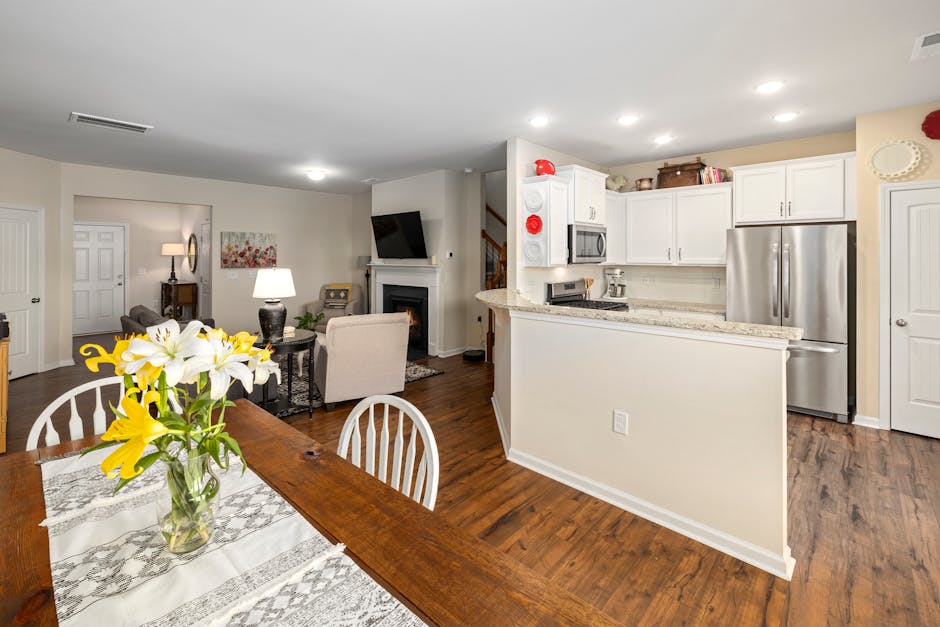Elegant Indoor Decoration Ideas for Open-Concept Living and Dining Areas
Introduction
Open-concept living and dining areas are increasingly popular, offering a sense of spaciousness and connection. However, decorating these spaces can be challenging. The key is to create a cohesive and elegant design that defines distinct zones without sacrificing the open flow. This article explores practical and stylish indoor decoration ideas for transforming your open-concept living and dining area into a harmonious and inviting space.
Creating Distinct Zones
Defining Zones with Rugs
Rugs are a powerful tool for visually separating the living and dining areas. Choose rugs of different sizes, shapes, and textures to define each zone. For example:
- Living Area: A large, plush rug can anchor the seating arrangement and create a cozy atmosphere.
- Dining Area: A durable, low-pile rug under the dining table can protect the flooring and define the dining space. Consider a rug that extends at least 24 inches beyond the table’s edges.
Strategic Furniture Placement
Use furniture to create subtle boundaries between the living and dining spaces. Consider these options:
- Sectional Sofa as a Divider: Position the back of a sectional sofa to subtly separate the living area from the dining area.
- Console Table or Bookshelf: A console table or low bookshelf can serve as a visual barrier without completely blocking the view. This offers storage and display space while defining the transition.
Lighting as a Zone Delineator
Different lighting schemes can further distinguish the living and dining areas:
- Living Area: Use layered lighting with a combination of ambient (overhead), task (reading lamps), and accent lighting (wall sconces). This creates a warm and inviting atmosphere.
- Dining Area: A statement pendant light or chandelier above the dining table acts as a focal point and defines the dining space. Consider dimmer switches for adjustable ambiance.
Elegant Decorating Ideas
Color Palette Cohesion
Maintaining a cohesive color palette is crucial for creating a unified look in an open-concept space. Opt for:
- A Consistent Color Scheme: Choose a primary color and two or three complementary accent colors. Use these colors throughout both the living and dining areas, varying their intensity and application.
- Neutral Base with Pops of Color: A neutral base (e.g., gray, beige, or white) provides a calming backdrop, allowing you to introduce pops of color through accessories, artwork, and textiles.
Artwork and Wall Decor
Use artwork and wall decor to create visual interest and tie the two spaces together:
- Unified Art Style: Choose artwork that complements each other in terms of style, color, or theme.
- Gallery Wall: A gallery wall spanning both areas can visually connect the spaces. Maintain a consistent frame style for a cohesive look.
Textiles and Fabrics
Incorporate textiles and fabrics that complement the overall design aesthetic:
- Coordinating Throw Pillows and Blankets: Use throw pillows and blankets in similar colors or patterns to tie the living and dining areas together.
- Window Treatments: Consistent window treatments, such as curtains or blinds, will unify the overall design.
Accessorizing with Style
Pay attention to the details and accessorize with items that reflect your personal style and enhance the elegance of the space:
- Plants: Introduce greenery with indoor plants to add life and freshness to the space.
- Decorative Objects: Use decorative objects such as vases, sculptures, and candles to add personality and create focal points.
Maximizing Space and Flow
Streamlined Furniture
Choose furniture pieces that are proportionate to the space and allow for easy movement:
- Avoid Overly Bulky Furniture: Opt for furniture with clean lines and a streamlined silhouette.
- Consider Multi-Functional Pieces: Furniture that serves multiple purposes, such as a storage ottoman or a dining table with extendable leaves, can maximize space.
Maintaining a Clutter-Free Environment
A clutter-free environment is essential for creating a sense of calm and elegance:
- Storage Solutions: Invest in storage solutions such as cabinets, shelves, and baskets to keep clutter out of sight.
- Regular Decluttering: Regularly declutter the space to maintain a clean and organized look.
Conclusion
Decorating an open-concept living and dining area requires careful planning and attention to detail. By strategically defining zones, maintaining a cohesive color palette, and incorporating elegant decor elements, you can transform your space into a stylish and inviting haven. Remember to prioritize functionality and flow to create a space that is both beautiful and practical. With a little creativity and effort, you can create an open-concept living and dining area that reflects your personal style and enhances your lifestyle.














Post Comment